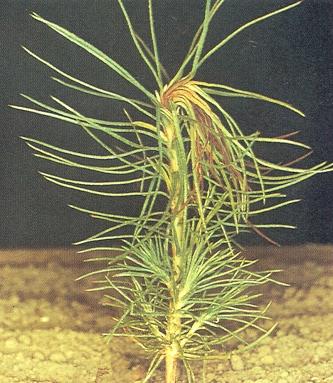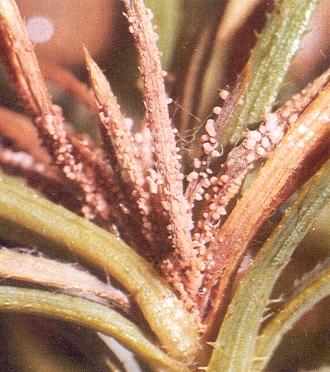PESTS AND DISEASES OF FORESTRY IN NEW ZEALAND
Colletotrichum acutatum - nursery disease
From Forest Pathology in New Zealand No. 16. Nursery diseases.
Based on Margaret Dick and AL Vanner (1986),
Revised by MA Dick (2008).
Causal organism
Colletotrichum acutatum Simmonds f. sp. pinea Dingley & Gilmour.
Type of injury
The terminal region of the stem of young seedlings grows around through 180 degrees, and its continued growth is suppressed.
Diagnostic features
- Crook-shaped stem terminal which may become reddish. Terminals of developing laterals may also be deformed (Fig. 3).
- Some dead needles on the malformed terminal. In severe cases, all needles in this region die and the stem becomes necrotic. Pink, pustule-like fruiting bodies of the fungus may be visible on dead needles (Fig. 4).
- Stem becomes stiff with abnormal increase in diameter growth.
- Diseased seedlings shorter than uninfected seedlings.
Hosts
Pinus contorta P. elliottii,. P. muricata,. P. nigra,. P. pinaster, P. ponderosa, P. radiata.
Distribution
The disease has been recorded in the North Island and in Nelson.

Fig. 3 -Pinus radiata seedlings showing the typical "terminal crook" symptom.

Fig. 4 - Pink pustules of the "terminal crook" fungus on infected needles of Pinus radiata.
Disease development
The disease mainly occurs in 1/0 stock, but 2/0 seedlings may sometimes be affected. There is no record of the disease developing in seedlings once they have been planted out on a forest site.
Infection occurs during warm, moist weather. Spores originate in infected soil debris and are dispersed by water splash. Those which land on the young needles on the seedling terminal germinate and penetrate the stem, which grows over into the typical crook shape. The infected needles in the terminal die and other needles in the apical shoot become yellow to light green in colour. The stem becomes much thicker and stiffer than normal and the malformed region of the stem may become reddish. If infection is severe, all the needles on the seedling terminal, and even the stem tissue, may die. This condition has been described as Terminal Blight. Under suitable environmental conditions, pink fruiting bodies develop on the dead needles and produce spores, which are distributed by water splash to nearby seedlings.
Affected seedlings remain in a dormant state until one of the upper lateral buds on the stem develops and grows into a dominant leader. This recovery may take place in the same growing season if the initial infection occurs very early in the growing season.
Economic importance
Under suitable climatic conditions large numbers of nursery seedlings can be affected in a very short time, and these seedlings must be discarded. The cost of prophylactic spraying is high.
Control
Where a nursery has no previous record of Terminal Crook disease, it is imperative that high standards of hygiene be maintained to prevent introduction of the disease. Tree stocks, soil, and machinery should not be introduced from nurseries in which the disease has been recorded.
Control can be achieved by applications of Sportak EW (450g/l prochloraz) at a rate of 1.5 l/ha at fortnightly intervals or 1.0 l/ha at weekly intervals in 500 litres of water per hectare.
This regime can be alternated with Shirlan (500g/l fluazinam) at a rate of 1.0 l/ha in 500 l water.
Spraying should be undertaken from seedling emergence until the end of March where there is high risk of disease. Some nurseries discontinue spraying during long periods of hot dry weather, where the disease risk is negligible
Overhead irrigation may create conditions suitable for disease development during dry weather.
Bibliography
Dick, M.A.; Vanner, A.L. 1986: Nursery diseases. New Zealand Forest Service, Forest Research Institute, Forest Pathology in New Zealand No. 16.
Dingley, J.M.; Gilmour, J.W. 1972: Colletotrichum acutatum Simmds. f.sp. pinea associated with "Terminal Crook" disease of Pinus spp. New Zealand Journal of Forestry Science 2:192-201.
Vanner, A.L.; Ray, J.W. 1977: Control of the disease "Terminal Crook" in pine seedlings. Fungicide and Nematicide Tests 32, Report No. 275.
Ray, J.W. 1975: "Terminal Crook" disease in pine nurseries. New Zealand Forest Service, Forest Research Institute, What's New in Forest Research No. 25.

 Farm Forestry New Zealand
Farm Forestry New Zealand

